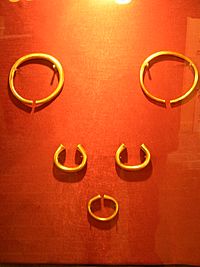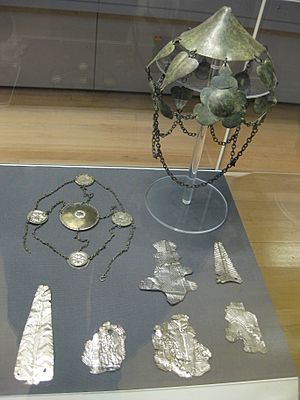Milton Keynes Hoard facts for kids
Quick facts for kids Milton Keynes Hoard |
|
|---|---|

Reproductions of the Milton Keynes Hoard of torcs and bracelets
|
|
| Material | Gold, bronze, pottery |
| Size | 2 gold torcs, 3 gold bracelets, bronze rod fragment, pottery bowl |
| Period/culture | Bronze Age Britain (middle to late) |
| Discovered | Monkston, Milton Keynes by Gordon Heritage and Michael Rutland in September 2000 |
| Present location | British Museum, London |
| Identification | 2000 (Fig 5) P&EE 2002.7–1.1–7 |
The Milton Keynes Hoard is a collection of amazing Bronze Age gold items. It was found in September 2000 in a field near Monkston in Milton Keynes, England. The hoard included two large gold torcs (necklaces), three gold bracelets, and a piece of bronze rod. All these treasures were inside a pottery bowl. Because the pottery was found with the gold, experts could tell the hoard was from around 1150 to 800 BC.
This incredible find weighs about 2 kilograms (4.4 pounds)! The British Museum called it "one of the biggest collections of Bronze Age gold known from Great Britain." They also said it helps us understand what life was like back then. The hoard was valued at £290,000 and is now kept at the British Museum in London.
Many other old treasures, including Roman hoards, have been found close to Milton Keynes. This shows the area has a long and interesting history.
Contents
- Finding the Ancient Gold Hoard
- Why This Hoard is So Special
- What Happened to the Hoard
- Other Amazing Finds Near Milton Keynes
- Castlethorpe Hoard Discovery
- Magiovinium's Ancient Coins
- Stony Stratford Hoard of Roman Treasures
- Whaddon Chase and Little Horwood Gold Coins
- Weston Underwood Coin Hoard from 1858
- New Bradwell Bronze Age Weapons Hoard
- Little Brickhill Roman Coin Discoveries
- Walton Coin Hoard from 1987
- Lenborough Hoard of 2014
- Maps
Finding the Ancient Gold Hoard
On July 7, 2000, two friends, Michael Rutland and Gordon Heritage, were using metal detectors in a field in Milton Keynes. They were invited by local archaeologists who were finishing a dig nearby. Suddenly, their detectors buzzed, and they found the amazing hoard!
They immediately told the archaeologists about their discovery. This was very important because it helped keep the historical information about the find safe. Experts from the British Museum also acted quickly to protect the site and dig up the items carefully. The metal detectorists were rewarded with 60% of the hoard's value. This happened after it was decided that the landowners' claim that the finders searched without permission was not true.
Why This Hoard is So Special
The Milton Keynes Hoard is made up of several important pieces. It has two large gold torcs, which are like fancy necklaces. There are also three smaller gold bracelets. A small piece of bronze rod was found too. All these items were inside a simple pottery bowl. This bowl was about 100 millimeters (4 inches) tall.
The heaviest gold item weighed about 627 grams (22 ounces). Experts used a special test called X-ray fluorescence to check the gold. They found that some items, like the second torc and a bracelet, were made of 85% pure gold!
The total weight of the gold is over 2 kilograms. The British Museum said this hoard "seems to flaunt wealth." This means it shows how rich and powerful some people were in the Bronze Age.
Because the finders reported the hoard quickly, experts could confirm that the gold and pottery belonged together. This helped them figure out the exact age of the hoard, between 1500 and 800 BC. The British Museum believes this find helps us understand the "social and economic picture" of Bronze Age Britain.
What Happened to the Hoard
A special meeting, called a coroner's inquest, officially declared the items as "treasure." This meant they were very old and important. The hoard was valued at £290,000. Michael Heritage and Gordon Rutland, the finders, were supposed to share this money with the landowners.
However, the landowners argued that the finders didn't have permission to search. But the Treasure Valuation Committee decided this claim was wrong. So, they increased the finders' share to 60% of the value.
The British Museum bought the hoard to keep it safe for everyone to see. But don't worry, you can still see copies of the gold items! replicas were made and are shown at the Milton Keynes Museum. This is a great way to remember where these amazing treasures came from.
Other Amazing Finds Near Milton Keynes
Before the Roman conquest of Britain around 43 AD, the Catuvellauni tribe lived in this area. They had a hill fort at Danesborough. Later, under Roman rule, the area grew because of a big Roman road called Iter III, also known as Watling Street. This road led to a Roman town called MAGIOVINIUM, which is now Fenny Stratford. People have lived in the Milton Keynes area for over 4,000 years! So, it's not surprising that many other hoards have been found nearby.
Castlethorpe Hoard Discovery
In 1827, near Castlethorpe, a Roman hoard was found. It contained coins, two silver bracelets shaped like snakes, and a silver finger ring with a special stone. These items were all inside a ceramic jar.
Magiovinium's Ancient Coins
Near the old Roman town of MAGIOVINIUM (Fenny Stratford), some very old coins were found.
- Fenny Stratford Gold Coin
In 1849, possibly the oldest known gold coin in Britain was found here. It was a gold stater from the mid-2nd century BC. The British Museum called it a "superb example" of Iron Age art.
- Bletchley Coin Hoards
Two other coin hoards, known as the "Bletchley" hoards, were found near MAGIOVINIUM in 1967 and 1987. These hoards contained silver coins called denarii.
Stony Stratford Hoard of Roman Treasures

In 1789, in a field near Stony Stratford, a pot was found. It held three fibulae (brooches) and two headdresses. It also had about 30 silver plaques with pictures of Roman gods like Mars, Apollo, and Victoria. There were also writings to Jupiter and Vulcan. This made people think it was a special offering at a Roman temple. This hoard is now at the British Museum.
Whaddon Chase and Little Horwood Gold Coins
In 1849, farmers working near Whaddon found a hoard of Iron Age gold staters. Reports say there were between 450 and 2,000 coins! But many people rushed to the spot and took some. About 320 coins ended up with the landowner.
In December 2006, in Little Horwood, three metal detectorists found 73 more staters. These coins were from 60–50 BC and were the same type as the Whaddon Chase find. Experts believe these coins were part of the original hoard that was not found in 1849. These 2006 coins were valued at £25,000 and are now in the Buckinghamshire County Museum.
One of the finders in 2006 was Gordon Heritage, who also helped find the Milton Keynes Hoard! In October 2007, the same three men found two more staters in the same area. The Whaddon Chase hoard is still the largest of its kind.
Weston Underwood Coin Hoard from 1858
On New Year's Eve in 1858, near Weston Underwood, Milton Keynes, a clay pot was found. It held 166 silver coins from the 1st and 2nd centuries AD. It also had other Roman coins, a complete Roman bowl, broken pottery pieces, and even human and horse bones. The Roman bowl is now at the Buckinghamshire County Museum.
New Bradwell Bronze Age Weapons Hoard
In 1879, at New Bradwell near Wolverton, Milton Keynes, a Bronze Age hoard of weapons was found. It included nine axes, three broken axes, a palstave (another type of axe), two Spearheads, and a broken sword. This collection is now at the Aylesbury Museum.
Little Brickhill Roman Coin Discoveries
In July 1962, a Roman coin hoard was found in Little Brickhill, very close to Watling Street. It had 251 loose coins and about 400 more that were stuck together. These coins were from 360–365 AD.
Two years later, more digging nearby found an old stone and timber building that had burned down. They found pottery from the 4th century, glass, beads, and about 43 coins. They also found the burial place of at least 44 people!
- More Coins at Little Brickhill
On May 20, 1967, a digging machine found another hoard of 296 silver coins from the 1st to 2nd centuries. They also found tools, pottery, and a sharpening stone. Five of these coins are at the British Museum, and the rest are at the Buckinghamshire County Museum. Later, in 1987, 627 more coins were found from the same hoard.
Walton Coin Hoard from 1987
In 1987, metal detectorists found 97 bronze coins from 307–317 AD at a building site in Walton, Milton Keynes. People thought there might be more coins from this hoard still hidden.
Lenborough Hoard of 2014
The Lenborough Hoard was found on December 21, 2014, near Padbury, about 13 miles west of Milton Keynes. This huge hoard had 5,251 coins from the 11th century! They were stored in a lead bucket and included coins from kings like Æthelred the Unready and Canute.
Maps

